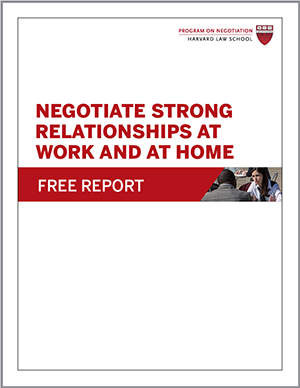
Here are 15 things about dispute resolution in environmental negotiations that Program on Negotiation faculty member Lawrence Susskind published on his website, Consensus Building Approach. In addition to being a PON faculty member, Professor Susskind a Massachusetts Institute of Technology (MIT) professor and Head of the Environmental Policy Group in the School of Architecture and Planning.
I was recently asked by my Harvard Law School class to summarize what we know (from actual experience) about environmental negotiations and environmental dispute resolution. I offered the following list. I’m eager to hear reactions from other scholars and practitioners.
1. Environmental dispute resolution (EDR) can be used “upstream” during policy-making and planning as well as “downstream,” once disputes have crystallized over administrative decisions (e.g. permitting, licensing, funding, etc.), or even after disputes have entered adjudication.
2. EDR only works if the parties are motivated to come to the negotiating table. It is fine if they have very different motivations (e.g. no good BATNA, an opportunity to create value, a desire to improve or repair relationships, pressure from coalition partners, etc.).
3. EDR needs a process manager; ideally, a professional mediator or facilitator (but not always). This person must be acceptable to all the parties being invited to come to the table.
4. The parties in EDR must have a chance to participate in or at least approve the agenda, ground rules, selection of parties, timetable, and other elements of process design before EDR begins.
5. It is perfectly reasonable, even necessary, for a facilitator or mediator to get involved in a variety of away-from-the-table activities on behalf of the group. These can include making sure that all parties are prepared properly. The mediator might also work with the parties to help them remain in touch with their actual or putative constituents throughout the EDR process.
6. EDR works best when there are opportunities for joint fact finding and they are managed by a facilitator or a mediator during environmental negotiations.
JFF should be highly interactive, involving all the stakeholder representatives in specifying the questions that need to be answered, selecting the experts of various kinds who will be called on to help, and making decisions about which analytical methods should be used.
7. EDR should always emphasize value-creating opportunities (and not just zero-sum choices).
8. EDR can never substitute for statutorily-mandated decision-making by public officials or agency staff. It can, however, supplement whatever formal decision making is required by law.
9. EDR will, of necessity, take different forms in different constitutional contexts around the world.
10. EDR can rarely, if ever, be precedent setting. It needs to be fitted to the unique contextual details of each dispute/conflict/decision-making process. The outcomes of EDR efforts are rarely recorded in the way court decisions are. They are not likely, therefore, to be accompanied by a legal rationale that justifies whatever agreement is reached.
11. EDR can include opportunities for confidential give-and-take among the participants even though open meeting laws, sunshine laws, and other transparency requirements must be met. Transparency is the mediator’s responsibility along with an obligation to maintain promises of confidentiality. These can be balanced by allowing the mediator to carry messages between the parties and through the work done in caucuses.
12. There are substantial advantages to creating EDR “systems” rather than treating each EDR opportunity anew. This often requires that dispute handling systems be enabled by statute or regulation.
13. The costs of EDR need not be shared equally by the parties. Each party can contribute what it can without compromising the nonpartisan or neutral stand of the mediator. Funds to support an EDR effort (regardless of who provides them) should only be allocated with the support of all the participants (perhaps through the involvement of an elected executive committee of stakeholders).
14. It is possible to evaluate and improve EDR efforts. It is unlikely, however, that consistent quantitative measures of benefits and costs will be central to such assessments. Rather, in-depth, case-by-case analyses – before, during, and after each effort- undertaken by independent evaluators are required. These tend to focus on the satisfaction of the parties relative to their pre-defined BATNAs along with their sense of how the process “worked” given the alternative ways of handling the situation that were available.
15. Parties involved in EDR should consult legal counsel. Court-connected EDR will undoubtedly involve parties and their lawyers throughout. The presence of lawyers in EDR, however, should not be allowed to create barriers to informal (problem-solving) dialogue among the parties themselves. Professional neutrals need not be attorneys in environmental negotiations.
What have I left out about environmental negotiations?
Originally published on Consensus Building Approach, “Fifteen Things We Know About Environmental Dispute Resolution,” by Lawrence Susskind, MIT professor and Head of the Environmental Policy Group in the School of Architecture and Planning and Program on Negotiation at Harvard Law School faculty member.
Originally posted in 2012.






Its unclear to me why this list is so specific to environmental rather than almost any governmental issue that involves stakeholders? It seems to me that the list is much more broadly applicable.
An environmental conflict which people are acting an important role in it, and policy makers try EDR; shows that social point of views and deep socio-political thoughts of people are a part of this conflict which won’t be solved by EDR completely, so remaining social pressure must be considered in EDR.
Several of these strategies among others recently led to successful resolution of the Flint Michigan water contamination case under the federal Safe Drinking Water Act.
Many environmental disputes uniquely involve not only public or collective interests and/or rights, but also the well-being of life sources around us which may or may not be represented at the table. This needs to be taken into consideration when negotiating or mediating many environmental questions. See for example the book “Should Trees Have Standing” by Christopher D. Stone.
I think that transparency is essential in environmental negotiations, considering the discussion of interests that often do not belong to parties or do not belong only to the parties, but are related to collective rights.
This observation leads to another question: If rights are collective and are unavailable to the negotiators, how can we create value?
Would be the environmental negotiations restricted to discussing forms and deadlines for fulfillment of environmental obligations?
This seems like a good list. However, in light of the many ongoing environmental disputes that are far from being resolved, can you give any examples/cases where any of these strategies led to succesful resolutions?